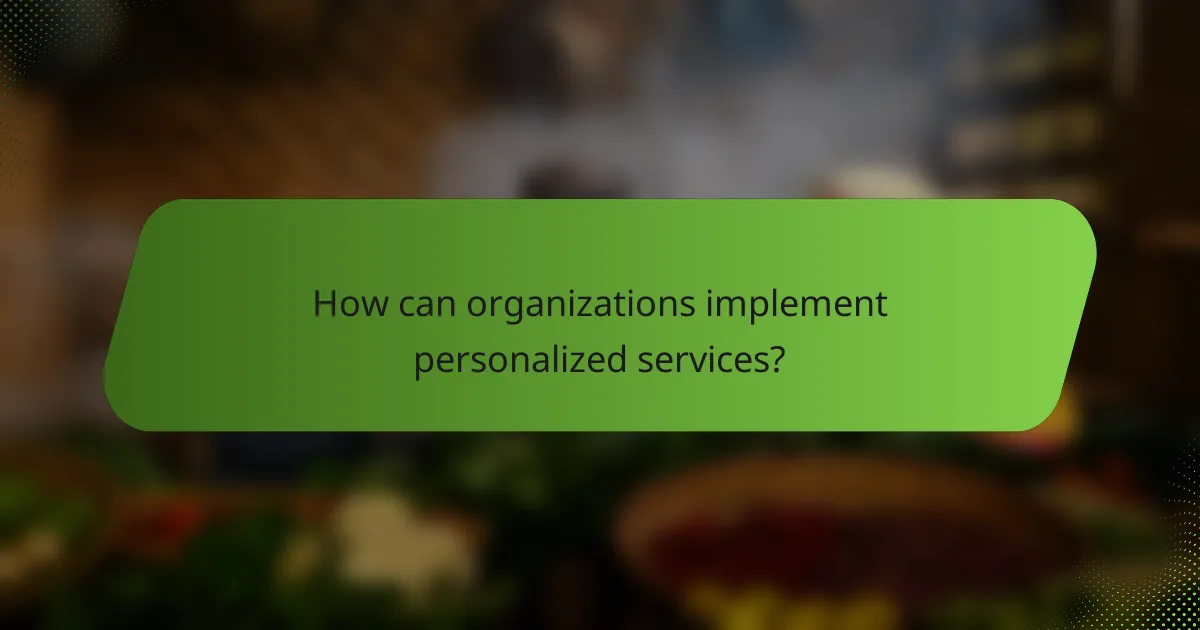Personalized services play a crucial role in enhancing member retention and engagement by offering tailored experiences that meet individual preferences. By utilizing data-driven strategies, organizations can effectively address specific needs, fostering loyalty and reducing churn rates. This approach not only improves satisfaction but also strengthens the overall relationship between members and the organization.

How do personalized services enhance member retention?
Personalized services significantly boost member retention by creating a more engaging and satisfying experience tailored to individual preferences. By addressing specific needs and preferences, organizations can foster loyalty and reduce churn rates among their members.
Increased member satisfaction
When services are personalized, members feel valued and understood, leading to higher satisfaction levels. This can be achieved through targeted communication, customized offers, and tailored support that resonates with individual members’ interests.
For instance, a fitness center might offer personalized workout plans based on a member’s fitness goals and preferences, enhancing their overall experience and likelihood of continued membership. Regular feedback mechanisms can also help organizations adjust services to meet evolving member needs.
Tailored experiences
Tailored experiences involve customizing interactions and offerings to align with member preferences. This can include personalized content, recommendations, and exclusive events that cater to specific interests, making members feel more connected to the organization.
For example, a subscription service might analyze user behavior to suggest products that match their tastes, increasing engagement and satisfaction. Organizations should regularly review member data to refine these experiences, ensuring they remain relevant and appealing.

What are effective personalized service strategies?
Effective personalized service strategies focus on tailoring experiences to individual member preferences and behaviors. By leveraging data and communication techniques, organizations can enhance member retention and engagement significantly.
Data-driven recommendations
Data-driven recommendations involve analyzing member data to provide tailored suggestions that align with their interests. This can include personalized product recommendations based on past purchases or browsing behavior.
To implement this strategy, organizations should invest in robust data analytics tools that can process member information efficiently. Regularly updating these insights ensures that recommendations remain relevant and timely.
Customized communication
Customized communication means delivering messages that resonate with individual members based on their preferences and interactions. This can include personalized emails, targeted promotions, or tailored content that speaks directly to their needs.
Utilizing segmentation techniques can help identify different member groups and craft messages that appeal to each segment. Avoid generic messaging, as it can lead to disengagement; instead, focus on creating a more intimate connection with members.
Exclusive member benefits
Exclusive member benefits are unique offerings that enhance the value of membership, such as special discounts, early access to new products, or members-only events. These incentives can significantly boost member loyalty and engagement.
When designing exclusive benefits, consider what appeals most to your members. Conduct surveys or focus groups to gather insights on desired perks. Ensure that these benefits are communicated clearly to reinforce their value and encourage ongoing participation.

How can organizations implement personalized services?
Organizations can implement personalized services by leveraging data-driven strategies that cater to individual member preferences and behaviors. This involves utilizing technology and data analytics to create tailored experiences that enhance member engagement and retention.
Utilizing CRM systems
Customer Relationship Management (CRM) systems are essential tools for organizations aiming to implement personalized services. These systems collect and analyze member data, enabling organizations to track interactions and preferences effectively.
By integrating a CRM system, organizations can automate communications and personalize outreach based on member history. For instance, sending targeted emails or offers based on previous purchases can significantly improve engagement rates.
Segmenting member data
Segmenting member data involves categorizing members into distinct groups based on shared characteristics or behaviors. This allows organizations to tailor services and communications to meet the specific needs of each segment.
Effective segmentation can be based on demographics, interests, or engagement levels. For example, a fitness center might segment members into categories such as beginners, intermediate, and advanced users, allowing for customized workout plans and promotions that resonate with each group.

What metrics measure the impact of personalized services?
Key metrics for assessing the impact of personalized services include member engagement rates and churn rates. These metrics provide insights into how effectively personalized services foster member loyalty and satisfaction.
Member engagement rates
Member engagement rates reflect how actively members interact with personalized services. High engagement typically indicates that members find value in tailored offerings, which can lead to increased loyalty and retention.
To measure engagement rates, consider tracking metrics such as login frequency, feature usage, and participation in personalized promotions. For instance, a gym might see higher engagement if members receive tailored workout plans and reminders, leading to more frequent visits.
Churn rates
Churn rates indicate the percentage of members who discontinue their relationship with a service over a specific period. A decrease in churn rates often signifies that personalized services are successfully meeting member needs and enhancing satisfaction.
To effectively monitor churn, analyze the reasons behind member departures and correlate them with the personalization efforts. For example, if members who receive personalized content show lower churn rates compared to those who do not, this suggests that tailored services are effective in retaining members.

What challenges exist in delivering personalized services?
Delivering personalized services involves several challenges that can hinder member retention and engagement. Key issues include data privacy concerns and the need for effective resource allocation to implement these tailored experiences.
Data privacy concerns
Data privacy is a significant challenge when offering personalized services, as members are increasingly aware of how their information is used. Organizations must comply with regulations such as GDPR in Europe or CCPA in California, which impose strict guidelines on data collection and usage.
To address these concerns, companies should prioritize transparency in their data practices. Clearly communicating how data is collected, stored, and utilized can help build trust with members. Additionally, offering opt-in options for data sharing can enhance member comfort and engagement.
Resource allocation
Effective resource allocation is crucial for delivering personalized services, as it requires investment in technology, staff training, and data analytics. Organizations must balance their budgets to ensure they can implement the necessary tools without compromising other operational areas.
To optimize resource allocation, businesses can start by identifying high-impact areas for personalization that align with member needs. This might involve leveraging existing technologies or platforms to minimize costs. Regularly assessing the effectiveness of personalized initiatives can also help in reallocating resources more efficiently over time.

How do personalized services compare across industries?
Personalized services play a crucial role in member retention and engagement across various industries by tailoring experiences to individual preferences. This approach enhances customer satisfaction and loyalty, leading to improved business outcomes.
Fitness memberships
In the fitness industry, personalized services often include tailored workout plans, one-on-one coaching, and customized nutrition advice. Gyms that offer these services can significantly improve member retention, as clients feel more invested in their fitness journey.
For example, fitness centers may use data from member assessments to create individualized training programs. This not only helps members achieve their goals but also fosters a sense of community and accountability.
To maximize engagement, fitness facilities should regularly check in with members to adjust their plans based on progress and feedback. Offering incentives for reaching milestones can also enhance motivation.
Subscription boxes
Subscription box services thrive on personalization by curating products based on customer preferences and past purchases. This tailored approach keeps subscribers excited about receiving their boxes, which can lead to higher retention rates.
For instance, a beauty subscription box might analyze customer feedback to include products that align with individual skin types or preferences. This level of customization not only enhances the customer experience but also encourages word-of-mouth referrals.
To maintain engagement, companies should regularly solicit feedback and adjust offerings accordingly. Providing options for members to customize their boxes further can lead to increased satisfaction and loyalty.

What are the future trends in personalized services for member engagement?
Future trends in personalized services for member engagement focus on leveraging advanced data analytics, artificial intelligence, and tailored communication strategies. These innovations aim to enhance user experiences by providing relevant content and services that resonate with individual member preferences.
Increased Use of Data Analytics
Data analytics will play a crucial role in understanding member behaviors and preferences. Organizations can analyze engagement patterns to tailor services and communications effectively. For example, tracking user interactions can help identify the best times to send personalized offers or content, improving overall engagement rates.
To implement this, consider investing in analytics tools that can process large datasets and provide actionable insights. Regularly reviewing these insights will allow organizations to adapt their strategies based on evolving member needs.
Artificial Intelligence and Machine Learning
Artificial intelligence (AI) and machine learning (ML) are set to revolutionize personalized services by automating the customization process. These technologies can analyze member data in real-time, enabling organizations to deliver personalized experiences at scale. For instance, AI can recommend products or services based on previous interactions, enhancing member satisfaction.
When adopting AI solutions, ensure they are user-friendly and integrate seamlessly with existing systems. Regular updates and training for staff will help maximize the effectiveness of these tools.
Tailored Communication Strategies
Personalized communication strategies will become increasingly important in member engagement. This includes using members’ names in communications, segmenting audiences based on interests, and sending targeted messages that address specific needs. Such approaches can foster a sense of belonging and loyalty among members.
To create effective tailored communications, utilize CRM systems that allow for segmentation and automation. Regularly assess the effectiveness of these strategies through member feedback and engagement metrics to refine your approach.
